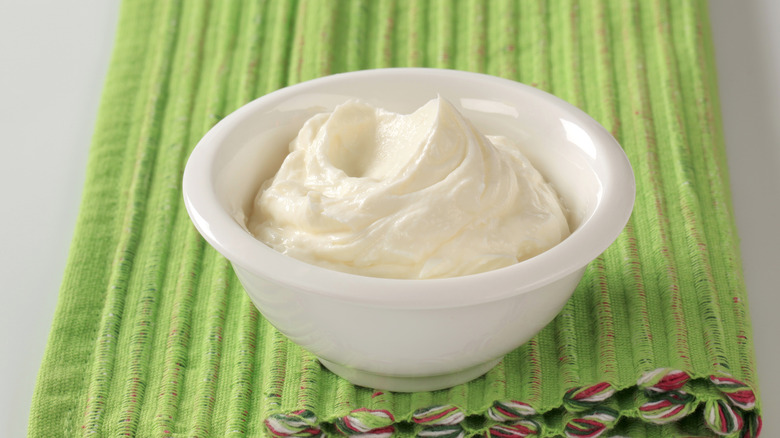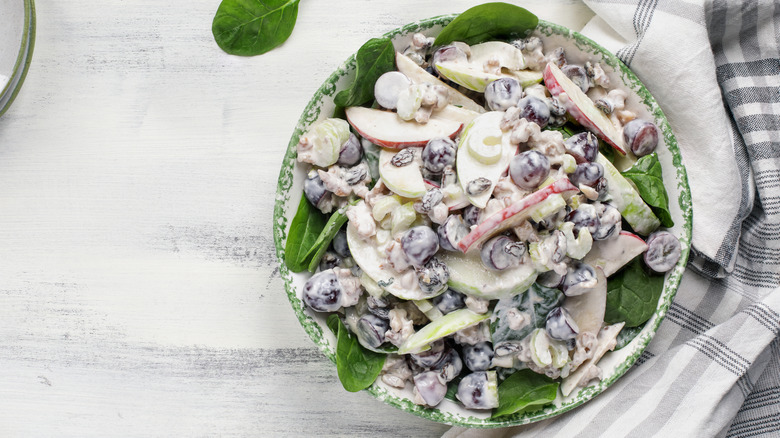Cream Cheese Is The Unexpected Base For A Delicious Salad Dressing
The earliest reference to cream cheese was during the 16th century, and since then, cream cheese has evolved into a seriously versatile ingredient. It can be stirred into a rich pasta ensemble, folded effortlessly into frosting for a carrot cake, or even blended into smooth ice cream. Its uses continually expand as it again demonstrates its marvelous flexibility in a delicious salad dressing.
Incorporating a cheesy dimension into your salad adds richness, saltiness, and texture. The soft texture of cream cheese allows it to seamlessly meld with other ingredients like olive oil, water or milk, herbs, and spices to create a simple yet utterly delectable dressing. Whizz the ingredients in a blender and let the taste do the talking.
The flavor of cream cheese can complement a variety of ingredients, which makes it a fantastic base. Fancy a slightly spicier affair or a particularly briney bite? No problem, cream cheese is the blank canvas for you to paint a variety of aromas onto. Your salad will only benefit from it.
The art of cream cheese salad dressing
Before you even think about mixing up any plain old cream cheese, consider choosing a reputable brand that will capture the creamy saltiness this dressing deserves. Next, ensure the cheese is at room temperature before mixing it into a dressing. It'll guarantee a smoother blend. Achieve a runnier consistency by using water or milk to dilute the dressing. Heavy cream may also be introduced if you prefer a fluffier dressing. How much you add is entirely up to you. In other words, add less dilutant if you like a thicker dressing.
For acidity, add apple cider vinegar or citrus juice. If you're apprehensive about a sharp bite of acidity, curb this with a little honey. For spice, chilis or mustard can be stirred through, and for a satisfying crunch, everything bagel seasoning will make an excellent addition. This illustrates how adaptable cream cheese dressing is. Get creative and try new combinations that resonate with your taste buds.
For the best results, leave all the ingredients to infuse before serving. An hour should be long enough to allow the flavors to develop fully. Once ready, ensure your salad ingredients are dry. Not only will watery greens lead to a soggy salad, but they may also dilute the dressing.
How to pair a cream cheese dressing
If you're wondering where a cream cheese salad dressing will excel, it will work effortlessly in a bound salad. A bound salad is held together by a dressing or binding agent (such as mayonnaise). A cream cheese dressing is ideal for a salad that's completely coated in the dressing as opposed to serving it on the side, although both will work.
Regarding leaves, crunchy leaves like radicchio or endive would go great with a cream cheese dressing as the cream cheese would offset their bitter edge. A rich dressing like this would also work well with iceberg or romaine lettuce, where the crisp leaves will hold their own against its thick consistency. While the salad police won't knock at your door for mixing this dressing with delicate leaves like arugula, it may swamp them. In this case, you can always dollop the dressing throughout the salad instead of mixing it in.
If you need inspiration for which salads to use, look toward those usually served with a creamy dressing. For instance, potato salad or Waldorf salad are wonderful examples of classically creamy fresh dishes that would work exceptionally well with a cream cheese dressing.
Cream cheese is a great option for your next salad dressing base. Its soft, mild, and cheesy nature will elevate fresh ingredients.


